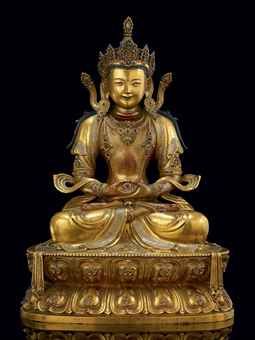Rare et importante sculpture d'Amitayus En bronze doré et laqué. Chine, dynastie Qing, Epoque Kangxi (1662-1722)
Rare et importante sculpture d'Amitayus en bronze doré et laqué. Chine, dynastie Qing, Epoque Kangxi (1662-1722). Photo: Christie's Images Ltd., 2010
Représenté assis en vajrasana sur un socle lotiforme, les mains en dhyanamudra tenant à l'origine le kalasha, vêtu d'un dhoti souple rehaussé d'un galon à motifs incisés de rinceaux et lotus, le torse nu, paré de colliers, bracelets et boucles d'oreilles incrustés de corail, lapis-lazuli et turquoise, le visage serein, les détails peints, la bouche fine, le nez aquilin, les yeux en amande, le front paré de l'urna, les cheveux bleus coiffés en un double chignon surmonté d'un ratna et agrémentés d'une tiare ouvragée, la peau laquée rouge et or, l'intérieur comportant des rouleaux de prières, ceux-ci entourant le bâton en bois, non scellé. Hauteur: 44 cm. (17¼ in.) - Estimate €150,000 - €200,000 Price Realized €961,000
Provenance: From an Austrian private collection.
Acquired before 1930 and since then in the same family.
Notes: Buddha Amitayus (in Chinese wuliangshou) is the deity associated with the rites that ensure long life. It is closely connected with Amitabha the Deity of Infinite Light and is thought to preside over the Western Paradise (Sukavati). Amitayus is especially worshipped by the Tibetans who believe that by faith and compassion, life can be extended through long lineages. It is believed that with help of Amitayus' life extending energy, one can achieve self-enlightment and welfare for others.
The elegance and fine quality of the figure of the Buddha with its slightly angular features, the very finely incised floral scrolling on the borders of the robes, and the intricate lotus throne base, over the edge of which flowing scarves trail, are all characteristic of the Buddhist bronzes of the Kangxi reign made in the Tibetan style. This statue, and other figures of this type, were made in the Imperial workshops. The heavy casting of the figure is indicative of a generous use of metal, including copper, which was always at a premium in imperial China, while the lacquer and gilding applied to the surface of the figure adds to its extravagance. This beautiful and serene figure is both a reflection of the religious beliefs of the Kangxi emperor (1662-1722) and a reminder of the political importance of Tibetan Buddhism (Lamaism) in the early Qing dynasty. Since the Qing dynasty was one in which China was ruled by foreigners, the Manchus, these emperors had, on the one hand to prove to their Chinese subjects that they held the Mandate of Heaven to rule, while, at the same time, dealing with China's frequently aggressive neighbours to the north. Most of the military challenges to the Manchus traditionally came from Inner Asia, with the Mongols being particularly troublesome. Much of the Manchus' success came from military supremacy, but in the late 17th and 18th centuries diplomacy was also employed to achieve the same ends. This was cemented by marriages between Manchus and the Mongol tribes: indeed the Kangxi emperor's grandmother was a Mongol princess. The Manchus, like the Mongols were converted to Tibetan Buddhism. In 1642 the Mongol leader Gui Khan had made the Fifth Dalai lama the secular as well as the religious ruler of Tibet. This power was expanded by the Fifth Dalai lama and his influence became such that he could act as peace-maker between Mongol tribes and could even order the movements of Mongol armies outside Tibet. The Qing court's relationships with the Mongols and Tibet were therefore inexorably intertwined, and remained so even after the Kangxi emperor's assumption of a protectorate over Tibet.
The Qing emperors portrayed themselves as bodhisattva-rulers, reincarnations of Manjusri (the Bodhisattva of Wisdom). In doing so they united the Tibetan view of the ruler as a living incarnation of a god with the Chinese Manjusri cult associated with the sacred Wutaishan in Shanxi province. This latter mountain, Wutaishan, was important in creating the image that the Qing emperors wanted to project to the Mongols and Tibetans. The emperors were patrons of temples in the area, and the Kangxi emperor made even five pilgrimages to Wutaishan.
Christie's. Art d'Asie, 15 December 2010, Paris www.christies.com

/https%3A%2F%2Fprofilepics.canalblog.com%2Fprofilepics%2F1%2F0%2F100183.jpg)



/http%3A%2F%2Fstorage.canalblog.com%2F98%2F47%2F119589%2F66015937_p.jpg)
/http%3A%2F%2Fstorage.canalblog.com%2F63%2F12%2F119589%2F66030364_p.jpg)
/http%3A%2F%2Fstorage.canalblog.com%2F92%2F26%2F119589%2F65764438_p.jpg)
/http%3A%2F%2Fstorage.canalblog.com%2F41%2F84%2F119589%2F65758811_p.jpg)